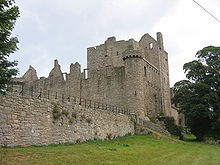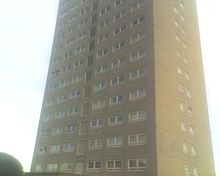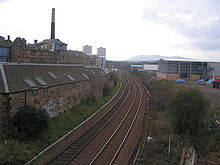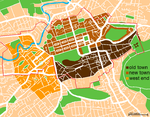- Craigmillar
-
Craigmillar (Scottish Gaelic: Creag a' Mhuilleir), from the Gaelic Crag Maol Ard, meaning 'High Bare Rock',[citation needed] is an area of Edinburgh, Scotland, about 3 miles (4.8 km) south east of the city centre, with Duddingston to the north and Newcraighall to the east.
Contents
History
The area consists mainly of inter-war and post-war public housing schemes, ranging from private bungalows to Edinburgh Council-owned high rise tower blocks. The housing schemes were created through the Housing (Scotland) Act of 1924, with lands bought from the Wauchope Estate. Despite the relative modernity of most of the housing in the area, the settlement of Craigmillar itself is very old, and contains Craigmillar Castle, which was begun in the late 14th or early 15th century, and occupied until the early 18th century. In 1660, the Craigmillar estate was bought by Sir John Gilmour, and Inch House remains the property of the Gilmour family.
Craigmillar Brewery formed an industrial focus for the area. Built in 1886 by William Murray of "Murray's Ales"[1] and also serving the Drybrough Brewery. Brewing ceased in 1950 but the majority of the buildings survived into the late 1990s before being cleared for modern flats.
Historical maps
In 2009 The National Library of Scotland released maps for the Craigmillar Area
- Ordnance Survey 1:10,560 Sheet IV SW, 1909 Shows detail of Niddrie House, Waterfall, Icehouse, Niddrie Stone 1909.
- Ordnance Survey 1:10,560 Sheet IV SW, 1938 Shows the development of Niddrie Main 1938.
- Ordnance Survey 1:10,560 - Air Photos - Sheet NT 27 SE and NT 37 SW, 1946 Shows the Arial Photos from 1946
- Ordnance Survey 1:10,560 Sheet NT 27 SE and NT 37 SW, 1955 Shows the Greendykes development. 1955
Present day maps
Openstreetmap volunteers completed Openstreetmap Craigmillar in January 2009
Facilities
Craigmillar saw riots in the 1980s, amid complaints about the lack of facilities in the area. Both the library and Arts Centre were won by grassroots-based community action trying to tackle the area's social problems. One such venture was the Craigmillar Festival Society, which was active from 1962 until 2002.
The area also has a large concrete sculpture/play-structure, created by artist Jimmy Boyle called Gulliver, The Gentle Giant that cares and shares. It was built for the Craigmillar Festival Society in 1976. The University of Edinburgh has playing fields in this area, including one of the oldest modern-style shinty fields in Scotland.
Gulliver is considered a geoglyph.
Regeneration of Craigmillar
An ambitious plan to re-develop parts of Craigmillar is currently underway. The Scottish Government's "Green Quarter Plan" proposes the creation of several new parks and woodland areas throughout the Craigmillar area. The "Green Quarter Plan" is being undertaken by the Parc life development company. They also propose the development of 3,200 affordable houses to rent and improved learning and leisure facilities for young people.[2]
One of the few retained buildings of significance is "The White House" public house, a listed building which is to be restored to its Art Deco glory in 2010/11 largely at public expense. Gallery spaces are to be created inside.
Transport
Craigmillar is served by Lothian Buses service 42 which runs from Portobello to Davidsons Mains, service 2 from The Jewel, Asda, to The Gyle Shopping Centre, service 14 from Greendykes to Muirhouse, service 21 from The Royal Infirmary of Edinburgh to The Gyle Shopping Centre, & service 30 from Musselburgh to Clovenstone, Wester Hailes.
The area was once served by a local railway from Duddingston & Craigmillar railway station on the Edinburgh Suburban and Southside Junction Railway. The station closed in 1962, but local pressure groups are campaigning to have the line re-opened, possibly as an extension of the forthcoming Edinburgh Tram Network.[3] Following a petition submitted to the Scottish Parliament in 2007, the proposal was rejected in 2009 by transport planners due to anticipated cost.[4]
Notable people
- Helen Duncan (1897–1956), the last woman to be imprisoned under the 1735 Witchcraft Act, lived in Craigmillar.
- Filmmaker Bill Douglas was born and raised in nearby Newcraighall.
- The former Craigmillar Primary School building houses a mural by the painter John Maxwell, who was trained by Fernand Léger and was a fellow student of Marc Chagall in Paris.
- There is a fine example of 20th century stained glass by Sadie Maclellan in Robin Chapel, in the Thistle Foundation, a housing complex for disabled people in the centre of Craigmillar.
- Local mother Helen Crummy was instrumental in the founding of the Craigmillar Festival Society in 1962.
External links
- Craigmillar community site
- Craigmillar Castle on Undiscovered Scotland
- Craigmillar Partnership
- CraigmillarOnline
- Robin Chapel
References
- ^ http://archiveshub.ac.uk/features/wmurray.html
- ^ "Regeneration of Craigmillar". Parc Life. http://www.parclife.co.uk/News-050506.aspx. Retrieved 2010-03-06.
- ^ "Reopening the South Sub". Transform Scotland. March 2007. http://archive.transformscotland.org.uk/info/docs/2007-03-30_ESSR.pdf. Retrieved 8 January 2010.
- ^ "Public Petitions Committee Official Report". Scottish Parliament. 27 January 2009. http://www.scottish.parliament.uk/s3/committees/petitions/or-09/pu09-0202.htm#Col1450. Retrieved 8 January 2010.
Categories:- Areas of Edinburgh
- Hill figures in Scotland
- Geoglyphs
Wikimedia Foundation. 2010.




